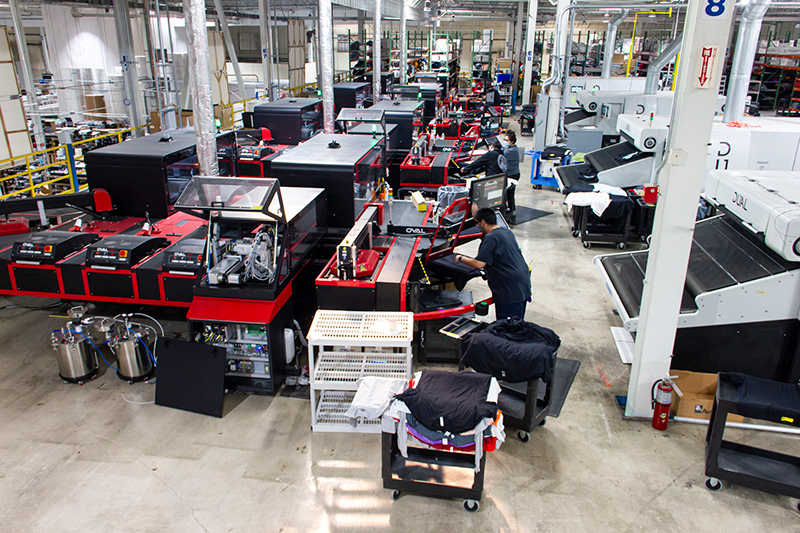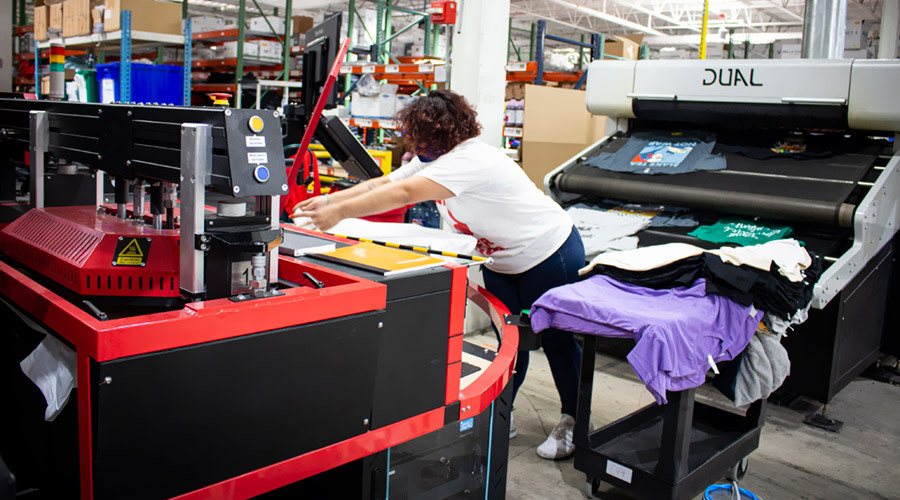DTG Printing revolutionized the way designs were printed on garments back in the 1990s. Since then, through various developments, it has made some significant advancements. This cost-effective, eco-friendly, and easy to use printing setup can print one garment at a time.
Let us see what DTG Printing is all about, the process, materials, cost, and comparison with other printing techniques.
What is DTG Printing?
DTG Printing stands for Direct-to-Garment Printing which is a technique which is a technique that involves jetting or spraying of special aqueous inks from print heads directly onto the surface of textiles, most notably t-shirts. DTG printing allows for unlimited colors in a single pass, unlike other t-shirt printing methods which are limited and typically charge an additional fee per color.
In DTG Printing the quality of the image printed on the textile is much higher and sharper. With DTG printing, one can print a single t-shirt or hundreds, all at a minimum cost when compared to other printing methods.
The first DTG printer that was commercially launched was named Revolution. With its introduction to the market in 1996, Direct-to-garment printing was made prevalent and gradually it became a phenomenon. Although this did not happen instantly. The technology was developed over the years, during which the market sales of the printer remained low.
In the 2005 ISS Atlantic city show, GT-541 was introduced by Brother International.
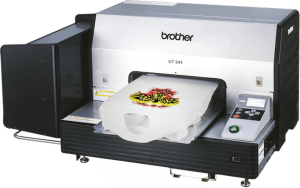
Later, in 2013, Epson launched the SureColor SC-F2000 printer which had a better shelf life and added advantages over the previous models.
How Does The DTG Printing Process Work?
The DTG printing process is very fast. At Marco Fine Arts, we can produce 240 full color garments per hour (that’s 20 full size shirts in 5 minutes).
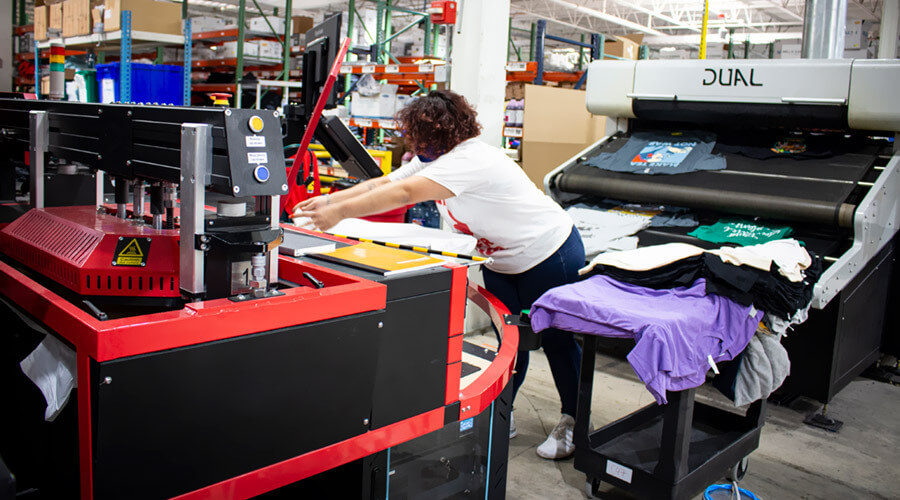
Here is a step-by-step guide to the printing process at most DTG printing houses:
- Step 1: The first thing you need to do is make sure your art is in a digital format that can be processed by the computer system. Proper attention should be paid to the quality and pigmentation of the graphic art, ensuring it suits the color and type of fabric.
- Step 2: Once editing the artwork is over, it needs to be sent to the printer.
- Step 3: Before you can use the garment, it needs to be pre-treated. There is a specialised machine to do this which only takes a few minutes to get the item treated.
- Step 4: After the treating procedure of the garment is complete, it has to be dried at 330 degrees Fahrenheit with a heat press for around 30 seconds until it is completely dried.
- Step 5: Once the garment is dry, it has to be placed on the DTG Printer and locked with a hoop to keep it positioned.
- Step 6: In this step, the machine prints the design it has received on the garment.
- Step 7: After the design is printed on the garment, it is taken to the heat press. A silicon sheet is placed above it and dried at the press very gently.
Finally, after the whole process is complete, the garment and print are checked for accuracy and product quality maintenance.
Working Smarter, Not Harder
Here at Marco Fine Arts we utilize the revolutionary Ovaljet technology. Which combines steps 3 – 5, with the printing process. The all-in-one machine allows you to secure the t-shirt into the printer, where it travels through the system for pretreatment, drying, and printing.
What type of designs works best with DTG?
DTG Printing is simple, affordable and very eye-catching. The inkjet technology helps the garment retain the bright colors that are used. However, certain rules need to be followed for the best outcome.
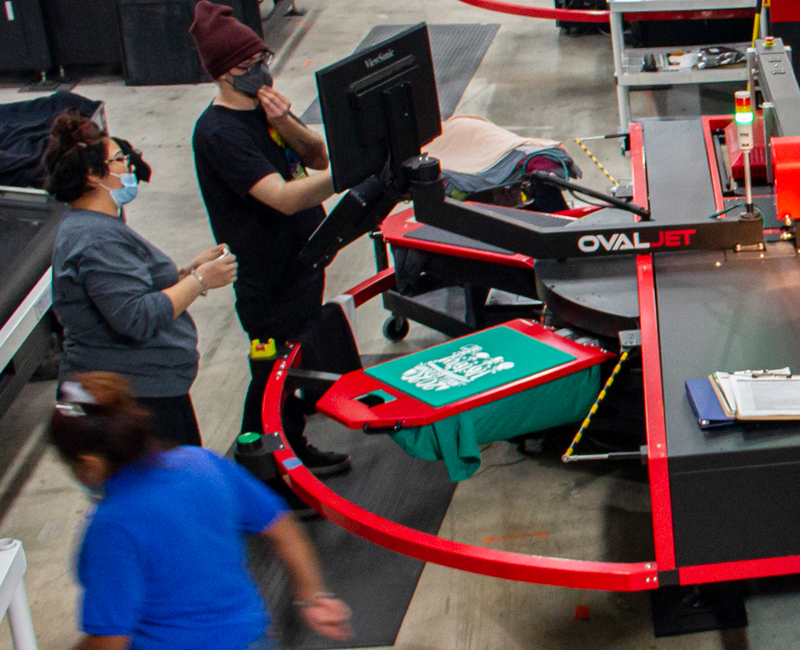
The first thing that affects print is fabric. Cotton is the best fabric to work within DTG Printing. It is easy to control and you have the guarantee of a perfect print because cotton threads have the power to absorb the ink that is ejected from the jet.
The other thing that you need to keep in mind is that the designs should be in contrast to the colors of the garment. For example, if you have a light-colored garment, you ought to use deeper and darker colors in your designs.
In DTG printing, bright colors and elaborate designs work the best. Try to use a wide variety of colors while making a design to be printed in this process.
DTG Printing costs overview
DTG printing needs a lot of setup before the printing process can be started. One needs to invest from $20,000 up to hundreds of thousands depending on the equipment you’re willing to invest in. As well as purchase the other raw materials that are required to complete the setup.
If you are aiming for the best quality setup, you might need to invest around $500,000 for it. Including the main DTG Printing machine, the heat press custom made for this purpose and ink cartridges. Faster machines such as this, which we use are significantly more expensive than smaller, slower individual machines.
Once you settle the whole mechanism, you have to invest in the garments if you want to sell your artwork through it.
You can also take advantage of third-party DTG printer makers (like Marco Fine Arts) where you don’t have to invest initially in any capital. You can simply send the designs to the third-party printers and receive the fulfilled order as soon as you approve the print file.
How Fast Is DTG Printing?
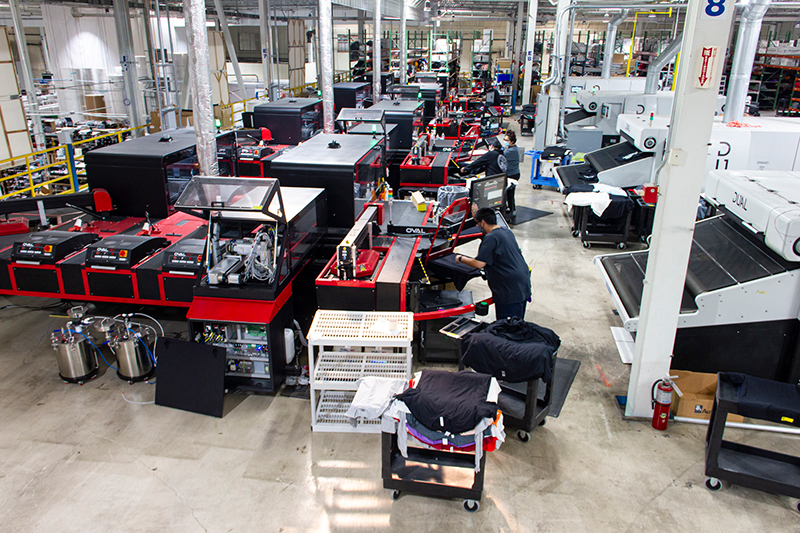
DTG Printing is a fast process. To start with, it takes much less time to set up the whole structure. This involves the placing of the machine and the fixing of the heat press.
Once that is done, the machine can print any design on the t-shirt. The creation of the artwork might take more time for some artists and less for some. It depends on the kind of design.
Being a creative task, this should not be considered as a part of the time requirement of the whole procedure. On the other hand, if one already has a design prepared, the only remaining task is to send it to the printer, which takes somewhere around three minutes.
That is how fast DTG Printing is and within a few minutes a normal garment can be beautifully enhanced with a design on it.
Why Should You Choose DTG vs. Other Printing Methods?
Unlike other printing methods such as Screen printing, DTG printing is easy and fast. If you choose any other printing method, the whole process gets complicated and there is generally a lot of cleanup and preparation to do.
When it comes to color blending and details of the design, DTG Printing wins the race. Because of the inkjet technology, every drop of the ink injected is well absorbed by the fabric in a still position.
Is DTG Printing eco-friendly?
Yes, DTG Printing is eco-friendly. The process of DTG printing is hassle-free. It is simple and usually involves only two or three machines. This helps in the reduction of waste produced.
When the printing happens directly on the fabric, there is no waste of ink and other materials. Another factor is that in this process you can print only one garment at a given time versus minimum order quantities required for screen printing. This means that no production waste occurs during the process of printing.
Conclusion
DTG Printing has seen a huge boom in the last decade. The cost-effectiveness, eco-friendliness and ease of use have been the major reason for such a phenomenon. Thousands of small businesses in the US are now setting up around this method of printing.
At Marco Fine Arts, we also use industry leading OvalJet DTG printers that produce high quality prints. OvalJet printers have automated stations that pretreat, dry and heat press garments in one smooth motion — reducing time and costs.
The quality of the final printing is durable and efficient and that is why DTG printing is in such demand. DTG Printing is the future of garment printing.
FAQs
Is DTG printing good quality?
Yes DTG Printing quality is one of a kind. This is because of the inkjet technology that is used which helps the fabric absorb the ink properly and the press heating adheres the ink to the fabric. This enhances the quality of the final finished product.
Is DTG printing better than screen printing?
Although both of them are very different in terms of procedure, DTG Printing is more efficient, incurs less waste, is much easier, faster and capable of utilizing millions of colors. DTG Printing is more cost-effective with a one-time investment benefit. Using the DTG printing mechanism, textile waste generation can be reduced as well.
How long does DTG printing last?
DTG Prints are extremely durable. The inkjet technology helps the cotton fabric to absorb the ink. This makes sure that no ink is spilled. Direct-to-garment prints last for many years because of how the design gets attached to the interwoven threads of cotton in the garment.
What are the cons of DTG Printing?
Most DTG printers cannot work with any other fabric than cotton, which restricts the customer’s choice. Newer generations of equipment are emerging however that allow for printing on poly blends and polyester fabric.


